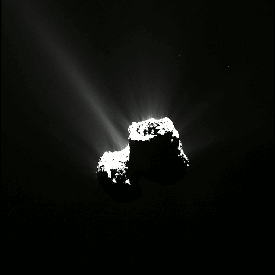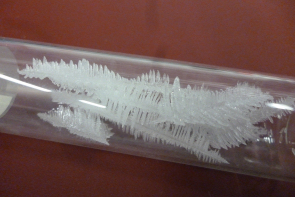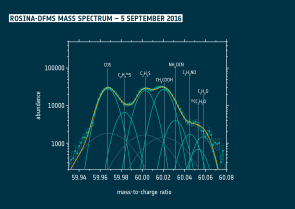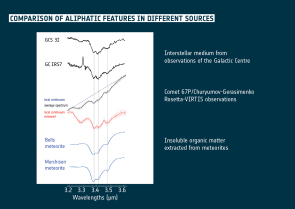Building blocks of life spotted on Rosetta's comet hint at composition of its birthplace
20 January 2020
Observations from ESA's Rosetta spacecraft are shedding light on the mysterious make-up of Comet 67P/Churyumov-Gerasimenko, revealing a mix of compounds thought to be essential precursors to life – including salts of ammonium and a particular type of hydrocarbons. These new studies suggest the comet gleaned this mate-rial from the presolar cloud where the Solar System formed 4.6 billion years ago. |
| Comet 67P. Credit: ESA/Rosetta/MPS for OSIRIS Team MPS/UPD/LAM/IAA/SSO/INTA/UPM/DASP/IDA |
Comets have a nucleus consisting of ice and dust, from which material sublimates when warmed by sunlight to form a gaseous enveloping 'coma'. These comas contain a mix of molecules that largely match theoretical predictions, with one outstanding exception: nitrogen gas, which is usually present in far smaller amounts than expected.
"The reason behind this nitrogen depletion has remained a major open question in cometary science," says Kathrin Altwegg of the University of Bern, Switzerland, principal investigator for the Rosetta Orbiter Spectrometer for Ion and Neutral Analysis (ROSINA) instrument and lead author of a new study.
"Using ROSINA observations of Comet 67P, we discovered that this 'missing' nitrogen may in fact be tied up in ammonium salts that are difficult to detect in space."
Ammonia, a molecule comprising one nitrogen and three hydrogen atoms, is one of the main carriers of volatile nitrogen, and readily combines with various acids found in both the space between stars and in cometary ice to form salts. These ammonium salts are thought to be the starting point for far more complex compounds – such as urea and glycine, the latter of which was also found on Rosetta's comet – that are known to be precursors to life as we know it on Earth.
 |
| Ammonium chloride. Credit: University of Bern |
"Finding ammonium salts on the comet is hugely exciting from an astrobiology perspective," adds Kathrin. "This discovery highlights just how much we can learn from these intriguing celestial objects."
Kathrin and colleagues used ROSINA data gathered during the final phase of the mission, from when Rosetta was performing close flyovers of the comet in September 2016. These data were somewhat serendipitous: Rosetta ventured closer to 67P than ever before, reaching just 1.9 km above the comet's surface, and became completely enshrouded by dust.
 |
| Ammonium salts sublimation products at Comet 67P. Credit: Altwegg et al. 2020 |
"Because of the dusty environment at the comet, and the rotation of Earth, we were not able to readily communicate with Rosetta via our antennas at the time and had to wait until the next morning to reestablish our communication link," says Kathrin.
"None of us slept well that night! But both Rosetta and ROSINA ended up behaving perfectly, flawlessly measuring the most abundant and most diverse mass spectra yet, and revealing many compounds we had never spotted on 67P before."
Adding to this investigation of 67P, another recent study made use of a different instrument on Rosetta, the Visible and Infrared Thermal Imaging Spectrometer (VIRTIS), which operated until May 2015, to explore the properties of the comet's nucleus.
The researchers explored several million infrared spectra gathered with VIRTIS and discovered clear signs of hydrogen and carbon chains known as organic aliphatic compounds – the first time such compounds have been spotted on the surface of a cometary nucleus.
 |
| Aliphatic compounds in different astronomical sources. Credit: Raponi et al. 2020 |
"Where – and when – these aliphatic compounds came from is hugely important, as they are thought to be essential building blocks of life as we know it," explains lead author Andrea Raponi of INAF, the National Institute for Astrophysics in Italy.
"The origin of material such as this found in comets is crucial to our understanding of not only our Solar System, but planetary systems throughout the Universe."
Comets are flung inwards towards the Sun from the outer reaches of the Solar System, and may deliver material to the inner planets as they travel. This material is thought to have either come from the young, still-forming Sun, or from the interstellar medium.
"We found that the nucleus of Comet 67P has a composition similar to the interstellar medium, indicating that the comet contains unaltered presolar material," says co-author Fabrizio Capaccioni, also of INAF and principal investigator for VIRTIS.
"This composition is also shared by asteroids and some meteorites that we have found on Earth, suggesting that these ancient, rocky bodies locked up various compounds from the primordial cloud that went on to form the Solar System."
"This may mean that at least a fraction of the organic compounds in the early Solar System came directly from the wider interstellar medium – and thus that other planetary systems may also have access to these compounds," adds Raponi.
Rosetta explored Comet 67P for over two years, ending its mission by crash-landing on the comet on 30 September 2016.
"Although Rosetta operations ended over three years ago, it is still offering us an incredible amount of new science and remains a truly ground-breaking mission," adds Matt Taylor, ESA's Rosetta Project Scientist.
"These studies tackled a couple of open questions in cometary science: why comets are depleted in nitrogen, and where comets got their material from. Inspiring discoveries such as these help us to understand a great deal more about not only comets themselves, but the history, characteristics and evolution of our entire cosmic neighbourhood."
Notes for editors:
"Evidence of ammonium salts in comet 67P as explanation for the nitrogen depletion in cometary comae" by K. Altwegg et al. and "Infrared detection of aliphatic organics on a cometary nucleus" by A. Raponi et al. are both published in Nature Astronomy.
Rosetta is an ESA mission. It launched in 2004 and rendezvoused with Comet 67P/Churyumov–Gerasimenko in 2014 to study it close up as it orbited around the Sun. It also deployed the lander Philae onto the comet's surface. Rosetta completed its mission by descending to the comet on 30 September 2016.
All Rosetta mission data is available in ESA's planetary science archive, here.
Browse Rosetta's images here.
For more information, please contact:
Kathrin Altwegg
University of Bern, Switzerland
Email: kathrin.altwegg![]() space.unibe.ch
space.unibe.ch
Andrea Raponi
Institute for Space Astrophysics and Planetology
INAF – National Institute for Astrophysics
Rome, Italy
Email: andrea.raponi![]() inaf.it
inaf.it
Fabrizio Capaccioni
Institute for Space Astrophysics and Planetology
INAF – National Institute for Astrophysics
Rome, Italy
fabrizio.capaccioni![]() iaps.inaf.it
iaps.inaf.it
Matt Taylor
ESA Rosetta project scientist
European Space Agency
Email: matt.taylor![]() esa.int
esa.int




